Jane Lindskold's Blog, page 28
December 14, 2022
Odd Decorations
 Dandy and Coco with Holiday Pals
Dandy and Coco with Holiday PalsEvery family that decorates for the holidays has it: the odd decoration that may raise the eyebrows of visitors, but is much beloved by the household.
Maybe it’s something made by a kid at school. Maybe it’s a gift from a loved friend. Maybe it’s a family heirloom. Whatever it might be, it belongs.
For me and Jim, even in a household with more than its share of odd decorations, probably the oddest is the ensemble known as The Twelve Guinea Pigs of Christmas.
I don’t remember what year we got them, but it was one of those when Jim had a field project, so I was handling a lot of our holiday shopping. One day, I came upon a display of little stuffy toys with Santa hats. Among them were guinea pigs! I bought a couple (because guinea pigs get lonely, so just one wouldn’t do), and surprised Jim with them when he got home that week.
For a fellow who, when we started dating, couldn’t understand why I had guinea pigs, Jim was pretty rapidly converted. He started offering to give them their treats, then check their food and water, and even to clean them. He has built them several hutches, including one on wheels.
But I didn’t think Jim was so thoroughly converted that he would decide we needed not the two or three little stuffy guinea pigs I’d gotten for us, but twelve. He searched until he found enough, and now, every holiday season, The Twelve Guinea Pigs of Christmas take up their place atop one of the tall bookcases in our office, where I can see them from my desk and smile.
What is your odd holiday decoration? If you don’t have one, well, I encourage you to indulge. Even if the budget is tight, you can upcycle something. Just remember to smile.
 The Twelve Guinea Pigs of Christmas
The Twelve Guinea Pigs of Christmas
December 9, 2022
FF: Re-Reading into the Holidays
 Roary Considers the Implications of Innocence
Roary Considers the Implications of InnocenceFor those of you unfamiliar with this column, the Friday Fragments lists what I’ve read over the past week. Most of the time I don’t include details of either short fiction (unless part of a book-length collection) or magazines. The Fragments are not meant to be a recommendation list. If you’re interested in a not-at-all-inclusive recommendation list, you can look on my website under Neat Stuff.
Except for the ARC of a novel that I’ve been looking forward to, I mostly focused on re-reading this week, as a loved story is a good backdrop at a very busy time.
Once again, this is not a book review column. It’s just a list with, maybe, a bit of description or a few opinions tossed in. And it’s also a great place to tell me what you’re reading.
Completed:
The Complete Miss Marple. Audiobook. I have listened to some of these short stories, but it’s interesting to hear how the choices made by a different reader cause subtle changes in interpretation. And, yes, I’ve read all the stories many times.
In Progress:
Into the Vortex by Charles E. Gannon. ARC. Sequel to This Broken World. Part epic fantasy, part mystery, with flourishes of horror and, as the title suggests, elements of isekai. Secrets lead only, as is so often the chase, to greater mysteries.
Last Ditch by Ngaio Marsh. Audiobook. Set late in the series, with most of the book focusing on Rick Alleyne, son of Troy and Roderick, a would-be young writer.
Also:
Jim and I had been rewatching the anime of Cardcaptor Sakura, by the Clamp consortium. I had a vague memory that the manga ending had been different, and got sucked into re-reading the last story arc, which fills two thick volumes. My memory was correct. In case you wonder, I prefer the manga ending! The second movie catches up with the manga, but took an angle I didn’t find as supported by the material. Side note: Don’t be fooled by the incredibly cute art. This is a story about collecting cards the way Moby Dick is a story about hunting whales.
Almost done with the latest issue of Smithsonian.
December 7, 2022
Always Something New
 Jerusalem artichoke tubers
Jerusalem artichoke tubersThis last week, I took a break and went out to dig up our Jerusalem artichokes. We’ve been growing these for a good number of years, having gotten the tubers from my friend, Sally Gwylan.
This year, I was astonished to find the large clump featured in the picture. Actually, it was even larger when I pulled it out, but a fair number of tubers fell free.
One of the reasons I enjoy gardening is that there are constant surprises, often good ones.
I enjoy writing for much the same reason.
And, with that in mind, I think I’ll go write.
 Jerusalem artichoke plants
Jerusalem artichoke plants
December 2, 2022
FF: Better Short or Long?
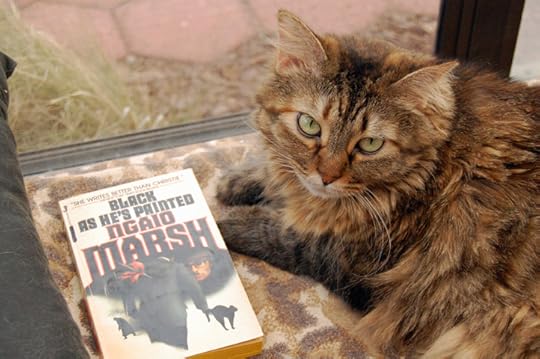 Mei-Ling Reads about Lucy Locket
Mei-Ling Reads about Lucy LocketThe edition of The Complete Miss Marple I’m listening to includes a short piece by Agatha Christie in which she muses how, although Miss Marple was featured in several novels, she always felt that her talents were best suited to short stories, while Poirot (who was certainly featured in many short stories) needed a novel to show off his particular talents. Very interesting indeed, and this awareness of how character shapes the tale is probably why Agatha Christie could excel at both long and short form.
For those of you unfamiliar with this column, the Friday Fragments lists what I’ve read over the past week. Most of the time I don’t include details of either short fiction (unless part of a book-length collection) or magazines. The Fragments are not meant to be a recommendation list. If you’re interested in a not-at-all-inclusive recommendation list, you can look on my website under Neat Stuff.
Once again, this is not a book review column. It’s just a list with, maybe, a bit of description or a few opinions tossed in. And it’s also a great place to tell me what you’re reading.
Completed:
The Frugal Gourmet Celebrates Christmas by Jeff Smith. About two-thirds anecdotes both about Christmas holiday traditions and Jeff Smith’s family traditions. The other third is, unsurprisingly, recipes.
Last Curtain by Ngaio Marsh. Audiobook. Painter Agatha Troy can’t resist the lure of a commission to paint a larger-than-life actor at his home, surrounded by his family, who seem eager to try and top each other as the most peculiar.
Black As He’s Painted by Ngaio Marsh. Audiobook. Politically-charged diplomatic murder, with prowl-bys by Lucy Locket, a former stray who finds a home with a retired diplomat.
In Progress:
Into the Vortex by Charles E. Gannon. ARC. Sequel to This Broken World. Part epic fantasy, part mystery. Secrets lead only, as is so often the chase, to greater mysteries.
The Complete Miss Marple. Audiobook. I have listened to some of these short stories, but it’s interesting to hear how the choices made by a different reader cause subtle changes in interpretation. And, yes, I’ve read all the stories many times.
Also:
Still reading the latest issue of Smithsonian.
November 30, 2022
Creative Chaos
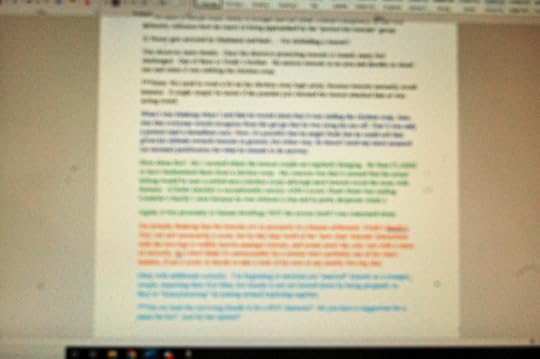 Colorful Discussion
Colorful DiscussionIt’s been one of those weeks. David Weber and I are busily brainstorming the details for our next Star Kingdom novel. (The most recent one, A New Clan, was released in June of this year.)
We started with e-mails, moved to a phone chat that went for two hours, bounced back to e-mails, interspersed with Facebook messages, then another phone chat. Our initial write-up based on that first telephone exchange is now several pages longer and looks like a patchwork quilt would if done in text.
To my initial write-up in black, Weber commented in dark blue. I replied in green. He replied in orange—and purple, when he had an afterthought, as one does. I replied in light blue. He replied again in red.
We backed and forthed, capped each other’s ideas. Figured out who would write which bits. It’s been ridiculous fun.
I don’t collaborate often. Honestly, I’m really very content as a soloist. Collaboration, as I’ve said before, is more work, not less, at least if each of the collaborators has honest respect for the other.
Pretty soon, the creative chaos will need to become creative order, but for now the wildness is rather fun.
And very colorful.
November 28, 2022
Last Days for Tamson House
Hi All…
Wanted to remind you that the Tamson House Auction ends on November 30.
What am I talking about? See here: https://janelindskold.wordpress.com/2022/11/03/shop-and-help-in-one/
Since I wrote this piece, there have been some fantastic donations, including several chances to have Zoom chats with authors and editors, one on one, for far less than you’d spend to chat in passing at a convention.
Take a look. Enjoy. Do interesting holiday shopping.
Most important, help Mary Ann Harris and Charles de Lint.
November 25, 2022
FF: Curling Up
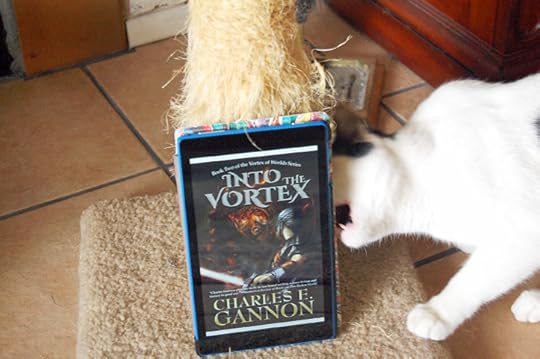 Roary the Ferocious!
Roary the Ferocious!The day after Thanksgiving is a great time to curl up and enjoy a good book…
For those of you unfamiliar with this column, the Friday Fragments lists what I’ve read over the past week. Most of the time I don’t include details of either short fiction (unless part of a book-length collection) or magazines. The Fragments are not meant to be a recommendation list. If you’re interested in a not-at-all-inclusive recommendation list, you can look on my website under Neat Stuff.
Once again, this is not a book review column. It’s just a list with, maybe, a bit of description or a few opinions tossed in. And it’s also a great place to tell me what you’re reading.
Completed:
River Kings: A New History of the Vikings from Scandinavia to the Silk Roads by Cat Jarman. Non-fiction. Curiosity about how a carnelian bead got from (possibly) India to a Viking grave in England sets an archeologist speculating. Very readable.
Tied up in Tinsel by Ngaio Marsh. Audiobook. Marsh kept from going stale by having more quirky characters and situations. In this one, a self-made rich man gets around the servant problem by giving positions to murders who he firmly believes are not likely to opt again for murder.
Light Thickens by Ngaio Marsh. Audiobook. This one is over half devoted to the events before the murder, the rehearsal and staging of a production of Macbeth. A daring choice by the author, but one that worked very well for me.
In Progress:
The Frugal Gourmet Celebrates Christmas by Jeff Smith. About two-thirds anecdotes both about Christmas holiday traditions and Jeff Smith’s family traditions. The other third is, unsurprisingly, recipes.
Into the Vortex by Charles E. Gannon. ARC. Sequel to This Broken World. Part epic fantasy, part mystery. I loved the first book, and am eager to read this sequel.
Last Curtain by Ngaio Marsh. Audiobook. Painter Agatha Troy can’t resist the lure of a commission to paint a larger-than-life actor at his home, surrounded by his family, who seem eager to try and top each other as the most peculiar.
Also:
I have finished the proofs for the mass market paperback edition of Library of the Sapphire Wind. Reading the latest issue of Smithsonian.
November 23, 2022
Storytelling Tradition
 Storytelling
Storytelling“When you’re writing, do you ever feel that you’re participating in a long storytelling tradition?”
This very interesting question came last week from one of the frequent commenters on my WW. My reaction was “Yes, and then again, No,” and so I decided to answer here.
So, here’s the “Yes.” Yes, of course I do. Remember, I have a PhD in English Literature (specializations in Medieval, Renaissance, and Modern). I cannot be unaware of the massive numbers of works that have come before my own.
Even within my own chosen area (SF/F), I am aware of trends, tropes, and traditions. Long before I started writing professionally, I read backwards to older works, as well as liberally sampling newer works. Sometimes I’m startled to see a reviewer talking about a work being “fresh and new,” when I can place it squarely within an established tradition. This doesn’t mean I lose respect for the author, but I usually lose some for the reviewer.
Here’s an example. I really enjoyed T.J. Klune’s House in the Cerulean Sea, even though I could call just about every plot point in advance. This didn’t matter, because the characters were lively, and I honestly cared about what happened to each and every one of them. So, well-written, yes. Fresh and new? Not really.
“No” comes in when I actually start writing. Then the dynamic is between me and my story. I’ll admit—and accept that some of you will want to argue with me—that I’m rather disturbed by the number of new releases, many from quite well-established authors, that rely heavily upon a previous work, sometimes print, sometimes film.
To me that’s less inspiration than taking the easy route, especially when the new work is then marketed with a strong reference to the root work. I’m much less likely to pick up the work if it’s presented that way. And, yes, I feel that way about fairytale retellings, as well. They need to bring something fresh to the original tale, not just change the time period or gender swap or some other gimmick.
So how do I balance the “yes” of my awareness of trends, tropes, and traditions, and my desire to tell a tale that’s all my own?
When I was writing the Firekeeper Saga (first book, Though Wolf’s Eyes), I was perfectly aware that I was a latecomer to the “feral child raised by wolves” tradition. In fact, Kipling’s The Jungle Books have been favorites of mine since I was a child. However, I felt I had my own tale to tell, chose plotlines that would not echo any of the Mowgli tales, and immersed myself in a world of my own creating. Firekeeper is her own person, not a gender swapped Mowgli.
My most recently published novels, Library of the Sapphire Wind and Aurora Borealis Bridge, definitely are within the tradition of portal fantasy—the type of story where people from our world end up somewhere else, usually because their help is needed. Moreover, my novels were written because of my frustration with the fact that in many of those works, the people going through the portal are quite young, often not even out of their tweens. It has always seemed unfair to me that the fate of a culture, a kingdom, even an entire world rests on the narrow shoulders of a kid.
Yes. There are portal fantasies (as well as a sub-section of time travel fiction) where the ones going through the portal are adults. However, these are often a sub-set of military fiction, where the knowledge and skills of those stepping elsewhere will be used for war. I wanted to do something different, more whimsical, but with lots of heart, but not sentimentality.
Once I started writing, I let my characters reference works of Fantasy and Science Fiction, but I made certain the world they were entering was not a copy of any previously written work or even of any culture on this Earth, past or present.
So, back to the original question, and why I’d answer both yes and no. Yes, I am very aware of my works being part of a tradition going all the way back to the days when storytellers told tales to eager listeners who knew story fed some mysterious part of themselves that they could hardly name. But, no, I’m not going to ever be one of those authors who will take advantage of someone else’s work entering public domain to pounce on it, wrestle it into my vision, and ride it to my own benefit.
Inspiration is one thing. Derivativeness is another.
Next question?
November 18, 2022
FF: Is It Okay?
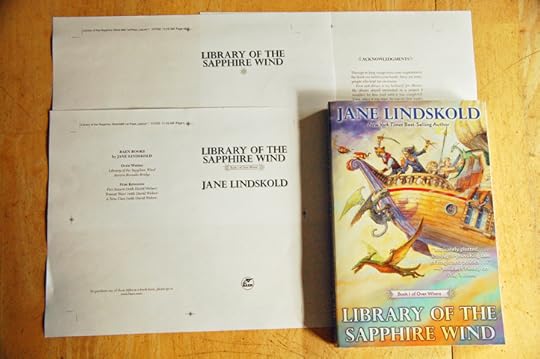 Preparing for Reincarnation
Preparing for ReincarnationI’m still reading the mass market proofs of my own novel Library of the Sapphire Wind, which was released as a trade paperback and e-book back in February of this year. Is it okay to like reading one’s own novel?
For those of you unfamiliar with this column, the Friday Fragments lists what I’ve read over the past week. Most of the time I don’t include details of either short fiction (unless part of a book-length collection) or magazines. The Fragments are not meant to be a recommendation list. If you’re interested in a not-at-all-inclusive recommendation list, you can look on my website under Neat Stuff.
Once again, this is not a book review column. It’s just a list with, maybe, a bit of description or a few opinions tossed in. And it’s also a great place to tell me what you’re reading.
Completed:
Died in the Wool by Ngaio Marsh. Audiobook. Another Alleyne mystery set in New Zealand.
In Progress:
River Kings: A New History of the Vikings from Scandinavia to the Silk Roads by Cat Jarman. Non-fiction. Curiosity about how a carnelian bead got from (possibly) India to a Viking grave in England sets an archeologist speculating. Very readable, but right now mostly reading just before bed.
Tied up in Tinsel by Ngaio Marsh. Audiobook. Marsh kept from going stale by having more quirky characters and situations. In this one, a self-made rich man gets around the servant problem by giving positions to murders who he firmly believes are not likely to opt again for murder.
Also:
Finished the most recent Archeology magazine.
P.S. The Zoom chat I’ve offered through the Tamson House auction still has a fairly low bid. I’ll chat with you and up to five friends about any aspect of writing, writing life, my works, whatever for a whole hour! Jim and guinea pigs will cameo upon request.
November 16, 2022
Rocks On!
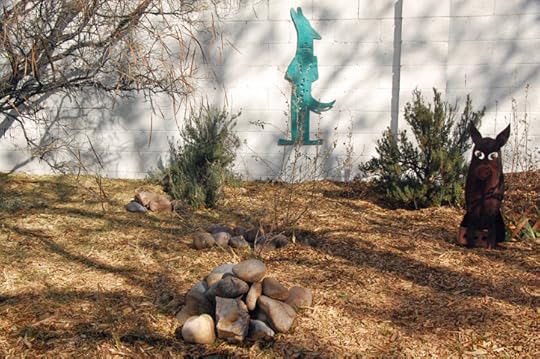 Cobbles, Coyote, and Puerco Real
Cobbles, Coyote, and Puerco RealI mentioned a few weeks ago that Jim and I had scored a very large amount of chipped and shredded wood mulch. We moved somewhere between ninety and a hundred garden carts of it to our back yard, and spread as much as we could without interfering with plants that hadn’t yet died back for the winter.
As our temperatures drop (we’ve hit the low twenties) and the summer plants die back, we’re slowly finishing spreading the mulch. As we finish up an area, we’re also placing and replacing the river cobbles we use as garden borders.
You might wonder why, given how hot our climate can be, especially in summer (last summer’s high was a relative cool 107 F), do we landscape with rocks?
It may seem odd, but our river cobbles help our local ecology in several ways. One of the most obvious is helping direct moisture, both when we get rain, and when we water. But rocks can also serve to help ameliorate our temperature shifts, which routinely shift at least 30 degrees between night and day, and not uncommonly shift 40 degrees or even 50.
Years ago, Jim and I planted a Tuscan Blue rosemary. Initially, it did well, but then it began to fail.
“Give it a rock,” said our friend Erich. “It will help the rosemary deal with temperatures shifts.” We were dubious, but we did. The Tuscan Blue rosemary is still with us, still thriving.
The use of rocks as a means of retaining moisture and managing temperature shifts goes way back. Jim has excavated sites going back 700 or more years, where the indigenous population created “waffle gardens” where river cobbles were often used to border gardens, sometimes covering much of the surface area. There are also examples of gravel mulched gardens as well.
So, as I crawl around my yard, moving river cobbles here and there, not only am I creating visual accents, I’m helping the wild plants to thrive, and participating in a longstanding gardening tradition.
Pretty cool, right?



